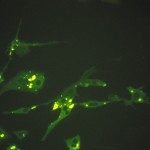Link to Pubmed [PMID] – 19856478
J. Med. Virol. 2009 Dec;81(12):2045-52
Hantaviruses (Bunyaviridae) cause hemorrhagic fever with renal syndrome (HFRS) in Eurasia and hantavirus (cardio)pulmonary syndrome (HCPS) in the Americas. HFRS is caused by Hantaan virus (HTNV), Seoul virus (SEOV), Dobrava virus (DOBV), Saaremaa virus (SAAV), and Puumala virus (PUUV). Of those, only HTNV is not present in Europe. In recent years, hantaviruses, described in other parts of Europe, were also detected at various locations in Hungary. To study the genetic properties of Hungarian hantaviruses in detail, sequences of the viral S and M segments were recovered from bank voles (Myodes glareolus), yellow-necked mice (Apodemus flavicollis), and striped field mice (Apodemus agrarius) trapped in the Transdanubian region. As expected, the sequences recovered belonged, respectively, to PUUV (two strains), DOBV (one strain), and SAAV (one strain). On phylogenetic trees two new Hungarian PUUV strains located within the well- supported Alpe-Adrian (ALAD) genetic lineage that included also Austrian, Slovenian, and Croatian strains. Analysis of the Hungarian SAAV and DOBV genetic variants showed host-specific clustering and also geographical clustering within each of these hantavirus species. Hungarian SAAV and DOBV strains were related most closely to strains from Slovenia (Prekmurje region). This study confirms that multiple hantaviruses can co-circulate in the same locality and can be maintained side-by-side in different rodent species.

